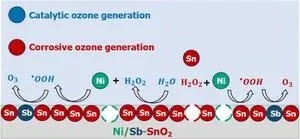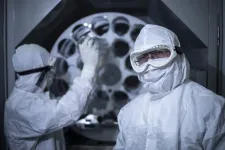(Press-News.org) Researchers at the University of Pittsburgh and Drexel University in Philadelphia, along with Brookhaven National Laboratory, are working to solve a multipart mystery to make water disinfection treatments more sustainable.
Scalable electrochemical ozone production (EOP) technologies to disinfect dirty water may someday replace centralized chlorine treatments used today, whether in modern cities or remote villages. However, little is understood about EOP at the molecular level and how technologies that make it possible can be made to be efficient, economical, and sustainable.
Their research, “Interplay between Catalyst Corrosion and Homogeneous Reactive Oxygen Species in Electrochemical Ozone Production,” was published recently in the journal ACS Catalysis (doi: 10.1021/acscatal.4c01317). Lead author is Drexel PhD student Rayan Alaufey, with contributing researchers from Drexel, including co-PI Maureen Tang, associate professor of chemical and biological engineering, postdoctoral researcher Andrew Lindsay, PhD student Tana Siboonruang, and Ezra Wood, associate professor of chemistry; co-PI John A. Keith, associate professor of chemical and petroleum engineering, and graduate student Lingyan Zhao from Pitt; and Qin Wu from Brookhaven.
“People have used chlorine to treat drinking water since the 19th century, but today we better understand that chlorine may not always be the best option. EOP for example can generate ozone, a molecule with about the same disinfecting power as chlorine, directly in water. Unlike chlorine which stably persists in water, ozone in water naturally decomposes after about 20 minutes, meaning it is less likely to damage people when consuming from water at a tap, when swimming in a pool, or when cleaning wounds in a hospital,” explained Keith, who is also R.K. Mellon Faculty Fellow in Energy at Pitt's Swanson School of Engineering.
“EOP for sustainable disinfection would make a lot of sense in some markets, but doing it requires a good enough catalyst, and because nobody has found a good enough EOP catalyst yet, EOP is too expensive and energy-intensive for broader use. My colleagues and I thought if we could decode at the atomic level what makes a mediocre EOP catalyst work, maybe we could engineer an even better EOP catalyst.”
Solving the mystery of how EOP catalysts work is crucial in understanding how to better engineer one of the most promising and least toxic EOP catalysts known to date: nickel- and antimony-doped tin oxide (Ni/Sb–SnO2, or NATO).
Therein, said Keith, lies the conundrum: what is every atom’s role in NATO doing to help EOP? Is ozone getting formed catalytically in ways we want it to, or does it form because the catalyst is decomposing, and future work needs to be done to make NATO catalysts more stable?
Surprisingly, the researchers discovered that it is probably a mix of both.
By using experimental electrochemical analyses, mass spectrometry, and computational quantum chemistry modeling, the researchers created an “atomic-scale storyline” to explain how ozone is generated on NATO electrocatalysts. For the first time, they identified that some of the nickel in NATO is probably leaching out of the electrodes via corrosion, and these nickel atoms, now floating in the solution near the catalyst, can promote chemical reactions that eventually generate ozone.
“If we want to make a better electrocatalyst, we need to understand what parts are working and not working. Factors like metal ion leaching, corrosion, and solution phase reactions can give the appearance that a catalyst is working one way when actually it is working another way.”
Keith noted that identifying the prevalence of corrosion and chemical reactions occurring away from the catalyst are important steps to clarify before other researchers can pursue improvements to EOP and other electrocatalytic processes. In their conclusion, they note that “Identifying or refuting the existence of such fundamental technological constraints will be critical to any future applications of EOP and other advanced electrochemical oxidation processes.”
“We know that electrochemical water treatment works on small scales, but the discovery of better catalysts will boost it to a global scale. The next step is finding new atomic combinations in materials that are more resistant to corrosion but also promote economically and sustainably viable EOP,” Keith said.
END
The Clues for Cleaner Water
Pitt, Drexel, and Brookhaven engineers solve the “catalysis vs corrosion” mystery in electrochemical ozone production
2024-05-06
ELSE PRESS RELEASES FROM THIS DATE:
New $14.5 million center to help US Navy overcome emerging challenges
2024-05-06
Images
The U.S. Office of Naval Research is tapping academic expertise at the University of Michigan to solve current and future problems, Secretary of the Navy Carlos Del Toro announced during his visit to campus over graduation weekend.
The $14.5M Center for Naval Research and Education will also help train an engineering research community familiar with naval and marine applications.
"I am incredibly proud of the partnership between the University of Michigan and the Department of the Navy. Michigan is a key teammate in rebuilding our shipbuilding industry and restoring the comprehensive—commercial ...
Now available from Penn Nursing: innovative, online psychedelic course
2024-05-06
PHILADELPHIA (May 6, 2024) – Penn Nursing is proud to launch a groundbreaking new online course – Educating Nurses in Psychedelic Assisted Therapy – via Open Canvas. This free comprehensive course is designed to prepare nursing professionals for the pioneering field of psychedelic assisted therapy (PAT), aligning with the latest advancements in mental health treatment and Penn Nursing's commitment to social justice in healthcare.
With this new modality of care on the horizon, the need for well-educated, ...
Greet receives funding for Abstraction in the Andes, 1950 - 1970
2024-05-06
Michele Greet, Director, Art History Program, received funding for: “Abstraction in the Andes, 1950-1970.”
She will examine the emergence of abstract painting in Andean countries (Peru, Ecuador, and Bolivia) in the 1950s and 1960s. She will explore artists’ newfound interest in pre-Columbian art as source material as well as the circulation of ideas from Europe and the United States.
Although abstract art rapidly gained acceptance throughout Latin America after World War II, until recently, studies of abstract painting in the region have focused on the geometric styles that emerged in Brazil, Argentina, and Venezuela. Different variants of abstraction ...
Mindfulness training enhances opioid addiction treatment
2024-05-06
Supplementing standard opioid addiction treatment with Mindfulness Oriented Recovery Enhancement (MORE) — an intervention that incorporates mindfulness training, savoring skills, and cognitive reappraisal — cuts program dropout rates by 59 percent and relapses by 42 percent, according to Rutgers-led research.
These trial results come from Rutgers Health amid unprecedented opioid abuse. An estimated 10 million Americans misuse opioids or have opioid use disorder, while annual overdose deaths have exceeded 80,000.
Treatment with methadone or buprenorphine – alone or in combination with cognitive behavioral therapy – is imperfect. Half ...
Using advanced genetic techniques, scientists create mice with traits of Tourette disorder
2024-05-06
In research that may be a step forward toward finding personalized treatments for Tourette disorder, scientists at Rutgers University–New Brunswick have bred mice that exhibit some of the same behaviors and brain abnormalities seen in humans with the disorder.
As reported in the Proceedings of the National Academy of Sciences, the researchers, using a technique known as CRISPR/Cas9 DNA editing that selectively modifies the DNA of living organisms, inserted the same genetic mutations found in humans with Tourette disorder into the corresponding genes in mouse embryos. After the mice were born, the scientists observed their behavior compared with littermates without the ...
3D video conferencing tool lets remote user control the view
2024-05-06
ITHACA, N.Y. -- Collaborating on a physical object when two people aren’t in the same room can be extremely challenging, but a new remote conferencing system allows the remote user to manipulate a view of the scene in 3D, to assist in complex tasks like debugging complicated hardware.
The system, called SharedNeRF, combines two graphics rendering techniques – one that is slow and photorealistic, and another that is instantaneous but less precise – to help the remote user experience ...
The Ottawa Hospital is expanding life-saving biotherapeutics research and manufacturing to its new campus thanks to $59 million grant
2024-05-06
The Ottawa Hospital is receiving $59 million to boost Canada’s capacity to develop and manufacture life-saving biotherapeutics, including vaccines, gene therapies and cell therapies. Most of the funding ($47 million) will support the construction and operation of a world-class biomanufacturing facility at The Ottawa Hospital’s new campus, while the remainder will enable harmonization and cooperation across six Canadian biomanufacturing facilities.
The funding is part of a $115 million investment from the Government of Canada in the Canadian Pandemic ...
Early neurodevelopmental assessments for predicting long-term outcomes in infants at high risk of cerebral palsy
2024-05-06
About The Study: The results of this study support the potential to identify cerebral palsy and its severity as early as corrected age 3 to 4 months through early neurodevelopmental assessments, but the role of these tests is limited in identifying cognitive and neurodevelopmental impairments.
Authors: Abdul Razak, M.D., of Monash University in Melbourne, Australia, is the corresponding author.
To access the embargoed study: Visit our For The Media website at this link https://media.jamanetwork.com/
(doi:10.1001/jamanetworkopen.2024.9053)
Editor’s ...
Snowfall and drought: $4.8 million field campaign will improve forecasts in western US, led by U-M
2024-05-06
Images
A new science expedition in Yampa Valley, Colorado, will improve forecasts of snowfall and estimates of how climate change will impact snowpack and water availability in the western U.S. mountains, funded with $4.8M from the National Science Foundation.
The field campaign, led by the University of Michigan, brings together scientists from the University of Washington, University of Wisconsin, University of Utah, Colorado State University and Stony Brook University. The team will use an extensive suite of radars and snow-sampling instruments to measure the size and shape of snowflakes and aerosols. ...
SwRI Workbench for Offline Robotics Development™ (SWORD™) launched at Automate 2024
2024-05-06
SAN ANTONIO — May 6, 2024 – Southwest Research Institute is simplifying robotics programming with a new toolkit that embeds computer-aided design (CAD) into robotics motion planning, modeling and execution. The SwRI Workbench for Offline Robotics Development™ (SWORD™) features a user-friendly graphical interface to demystify the fundamental coding required in robot operating system (ROS) application development.
Informed by the Institute’s role in supporting the ROS-Industrial community, SwRI developed ...
LAST 30 PRESS RELEASES:
Making lighter work of calculating fluid and heat flow
Normalizing blood sugar can halve heart attack risk
Lowering blood sugar cuts heart attack risk in people with prediabetes
Study links genetic variants to risk of blinding eye disease in premature infants
Non-opioid ‘pain sponge’ therapy halts cartilage degeneration and relieves chronic pain
AI can pick up cultural values by mimicking how kids learn
China’s ecological redlines offer fast track to 30 x 30 global conservation goal
Invisible indoor threats: emerging household contaminants and their growing risks to human health
Adding antibody treatment to chemo boosts outcomes for children with rare cancer
Germline pathogenic variants among women without a history of breast cancer
Tanning beds triple melanoma risk, potentially causing broad DNA damage
Unique bond identified as key to viral infection speed
Indoor tanning makes youthful skin much older on a genetic level
Mouse model sheds new light on the causes and potential solutions to human GI problems linked to muscular dystrophy
The Journal of Nuclear Medicine ahead-of-print tip sheet: December 12, 2025
Smarter tools for peering into the microscopic world
Applications open for funding to conduct research in the Kinsey Institute archives
Global measure underestimates the severity of food insecurity
Child survivors of critical illness are missing out on timely follow up care
Risk-based vs annual breast cancer screening / the WISDOM randomized clinical trial
University of Toronto launches Electric Vehicle Innovation Ontario to accelerate advanced EV technologies and build Canada’s innovation advantage
Early relapse predicts poor outcomes in aggressive blood cancer
American College of Lifestyle Medicine applauds two CMS models aligned with lifestyle medicine practice and reimbursement
Clinical trial finds cannabis use not a barrier to quitting nicotine vaping
Supplemental nutrition assistance program policies and food insecurity
Switching immune cells to “night mode” could limit damage after a heart attack, study suggests
URI-based Global RIghts Project report spotlights continued troubling trends in worldwide inhumane treatment
Neutrophils are less aggressive at night, explaining why nighttime heart attacks cause less damage than daytime events
Menopausal hormone therapy may not pose breast cancer risk for women with BRCA mutations
Mobile health tool may improve quality of life for adolescent and young adult breast cancer survivors
[Press-News.org] The Clues for Cleaner WaterPitt, Drexel, and Brookhaven engineers solve the “catalysis vs corrosion” mystery in electrochemical ozone production



